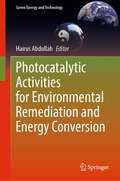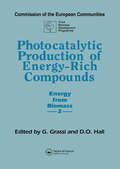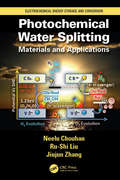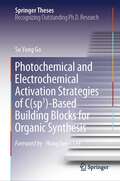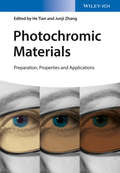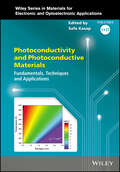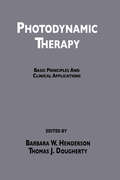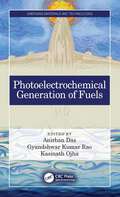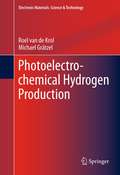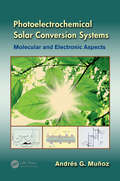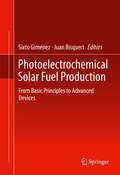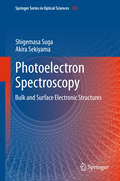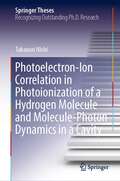- Table View
- List View
Photocatalytic Activities for Environmental Remediation and Energy Conversion (Green Energy and Technology)
by Hairus AbdullahThis book highlights sustainable methods with photocatalytic activities to remediate environment and for energy conversion. The related photocatalytic materials are discussed in detail. Some significant photocatalytic applications in degrading industrial pollutants that include different organic dyes, purifying the polluted air, converting CO2 to alcohol fuels, storing energy from sunlight as ammonia by converting N2 to NH3, and splitting water by optimizing the oxygen evolution process are thoroughly elucidated. The chapters introduce the necessary materials and results, leading to a better conceptualization in order to work in the field of photocatalysis. Some related perspectives and outlooks are discussed in the last chapter for possible future developments.
Photocatalytic Activity Enhancement of Titanium Dioxide Nanoparticles
by Mohamed A. Barakat Rajeev KumarIn this brief, a comprehensive review of the UV/visible-TiO2 photocatalytic oxidation process is presented with an insight into the mechanisms involved, the role of titanium dioxide as a catalyst, irradiation sources, types of reactors, and a comparison between various modes of TiO2 application. An overview of the development and enhancement of the activity of TiO2 nanoparticles in photocatalysis is presented. The topics covered include a detailed look at the unique properties of the TiO2 nanoparticles and their relationship to photocatalytic properties. The utilization of the TiO2 nanoparticles as photocatalysts, in the non-doped and doped forms is also reviewed. Finally, the use of modified TiO2 nanoparticles has made a significant contribution in providing definitive mechanistic information regarding the visible light photocatalytic processes.
Photocatalytic Hydrogen Fuel Generation: Designing Highly Efficient Semiconductor Materials (Green Energy and Technology)
by Hairus AbdullahThis book highlights crucial parameters and strategies in photocatalytic water splitting. The process utilizes light energy to drive the separation of water into hydrogen and oxygen with the help of a photocatalyst. The efficiency and performance of catalytic activities are determined by various parameters supported by material characterizations. Commonly, the catalytic performances in visible-light photocatalytic water splitting are governed by bandgap energy, surface area, crystal structure, charge carrier dynamics, catalyst loading, cocatalyst, pH of solution, and reaction temperatures. However, covering all the requirements to obtain a highly efficient catalytic activity is an impossible task. Some recent strategies with promising results have been explored to improve and optimize the catalytic properties. In addition, various techniques for catalytic material characterizations, such as XRD, SEM, TEM, XPS, XANES, EXALFS, TRPL, TPC, EIS, and CV analysis, are also discussed. Finally, some related perspectives and outlook are discussed for future development.
Photocatalytic Production of Energy-Rich Compounds
by G. Grassi D.O. HallThis workshop comprises part of the four-year (1985-1988) non-nuclear energy R & D programme for the development of renewable energy sources which is being implemented by the Commission of the European Communities. The aim of the workshop was to present work by the contracting laboratories in addition to work by numerous other research laboratories
Photocatalytic Semiconductors
by Aracely Hernández-Ramírez Iliana Medina-RamírezThis critical volume examines the different methods used for the synthesis of a great number of photocatalysts, including TiO2, ZnO and other modified semiconductors, as well as characterization techniques used for determining the optical, structural and morphological properties of the semiconducting materials. Additionally, the authors discuss photoelectrochemical methods for determining the light activity of the photocatalytic semiconductors by means of measurement of properties such as band gap energy, flat band potential and kinetics of hole and electron transfer. Photocatalytic Semiconductors: Synthesis, Characterization and Environmental Applications provide an overview of the semiconductor materials from first- to third-generation photocatalysts and their applications in wastewater treatment and water disinfection. The book further presents economic and toxicological aspects in the production and application of photocatalytic materials.
Photochemical Behavior of Multicomponent Polymeric-based Materials
by Visakh P. M. Dan RosuThis book offers in-depth insights into the photochemical behavior of multicomponent polymeric-based materials, with a particular emphasis on the photodegradation and photostabilization of these materials. Studying various classes of materials bases such as polysaccharides, wood, synthetic polymers, rubber blends, and nanocomposites, it offers a valuable reference source for graduate and postgraduate students, engineering students, research scholars and polymer engineers working in industry.
Photochemical Water Splitting: Materials and Applications
by Jiujun Zhang Ru-Shi Liu Neelu ChouhanCleavage of water to its constituents (i.e., hydrogen and oxygen) for production of hydrogen energy at an industrial scale is one of the "holy grails" of materials science. That can be done by utilizing the renewable energy resource i.e. sunlight and photocatalytic material. The sunlight and water are abundant and free of cost available at this planet. But the development of a stable, efficient and cost-effective photocatalytic material to split water is still a great challenge. To develop the effective materials for photocatalytic water splitting, various type of materials with different sizes and structures from nano to giant have been explored that includes metal oxides, metal chalcogenides, carbides, nitrides, phosphides, and so on. Fundamental concepts and state of art materials for the water splitting are also discussed to understand the phenomenon/mechanism behind the photoelectrochemical water splitting. This book gives a comprehensive overview and description of the manufacturing of photocatalytic materials and devices for water splitting by controlling the chemical composition, particle size, morphology, orientation and aspect ratios of the materials. The real technological breakthroughs in the development of the photoactive materials with considerable efficiency, are well conversed to bring out the practical aspects of the technique and its commercialization.
Photochemical and Electrochemical Activation Strategies of C (Springer Theses)
by Su Yong GoThis book addresses novel C(sp3)-C(sp2) and C(sp3)-heteroatom bond-forming reactions. Two strategies are given in the book using photoredox or electrochemical methods. The first strategy describes that the hydroalkylation of alkynes via photoredox-mediated Ni/Ir dual catalysis produces trisubstituted alkenes as versatile synthetic building blocks for the synthesis of pharmaceutical agents and natural products. High regioselectivity and E/Z-selectivity were achieved by introducing silyl groups that can provide steric and electronic effects to these selectivities with extensive opportunities for post-functionalization.The second strategy enables the development of C(sp3)-heteroatom bond-forming reactions through the electrochemical activation of C(sp3)-B bonds. The bonding of heteroatoms to carbon atoms has been an enduring subject of investigation for organic chemists. The function of most molecules is mainly determined by heteroatoms attached to the carbon atom, althoughthe backbone structure of organic compounds comprises carbon fragments.
Photochemistry for Biomedical Applications: From Device Fabrication to Diagnosis and Therapy
by Yoshihiro ItoThis book describes medical applications of photochemistry. In the first part, a general introduction to photochemistry and related phototechnologies is provided. In the second part, photochemistry-based medical applications for diagnostics (biochips and bioimaging) and therapeutics (biomaterials for artificial organs, medical adhesives, dental materials, drug-delivery systems, tissue engineering, and photodynamic therapy) are described, with examples of recent research. The year 2015 is the International Year of Light and Light-Based Technologies. Light plays a vital role in our daily lives and is important in many interdisciplinary scientific fields in the twenty-first century. Light-based concepts have revolutionized medicine, including areas such as oncology, molecular biology, and surgery. Although photochemistry has contributed significantly to medicine directly and through photochemical fabrication of biomaterials, a book giving a comprehensive overview of recent progress has not been published until now. The aim of this book is to highlight the contributions of photochemistry in interdisciplinary fields of chemistry and medical engineering. This book will be useful for chemists who are interested in medical applications of photochemistry and engineers who are eager to learn the principles of photochemistry to enable its use in practical applications.
Photochromic Materials: Preparation, Properties and Applications
by He Tian Junji ZhangSummarizing all the latest trends and recent topics in one handy volume, this book covers everything needed for a solid understanding of photochromic materials. Following a general introduction to organic photochromic materials, the authors move on to discuss not only the underlying theory but also the properties of such materials. After a selection of applications, they look at the latest achievements in traditional solution-phase applications, including photochromic-based molecular logic operations and memory, optically modulated supramolecular system and sensors, as well as light-tunable chemical reactions. The book then describes the hot-spot areas of photo-switchable surfaces and nanomaterials, photochromic-based luminescence/electronic devices and bulk materials together with light-regulated biological and bio-chemical systems. The authors conclude with a focus on current industrial applications and the future outlook for these materials. Written with both senior researchers and entrants to the field in mind.
Photoconductivity and Photoconductive Materials: Fundamentals, Techniques and Applications (Wiley Series in Materials for Electronic & Optoelectronic Applications)
by Peter Capper Arthur WilloughbyExplore an authoritative resource with coverage of foundational concepts of photoconductivity and photoconductive materials In Photoconductivity and Photoconductive Materials, Professor Kasap delivers a definitive guide to the basic principles of photoconductivity and a selection of present topical photoconductive materials. Divided into two parts, the set begins with basic concepts and definitions and coverage of characterization using steady state, transient and modulated photoconductivity techniques, including the novel charge extraction by linearly increasing voltage (CELIV) method The physics of terahertz photoconductivity and fundamentals of organic semiconductors lsois are also covered. Part Two of the set starts with a comprehensive review of a wide range of photoconductive materials and then focuses on some of the most important photoconductors, including hydrogenated amorphous silicon, cadmium mercury telluride, various x-ray photoconductors, diamond films, metal halide perovskites, nanowires and quantum dots. Photoconductive antenna application is also included. Filled with contributions from leading authors in the field, this book also offers: A thorough introduction to the characterization of semiconductors from photoconductivity techniques, including uniform illumination and photocarrier grating techniques Comprehensive explorations of organic photoconductors, including photogeneration, transport, and applications in printing Practical discussions of time-of-flight transient photoconductivity, including experimental techniques and interpretation In-depth examinations of transient photoconductivity of organic semiconducting films and novel transient photoconductivity techniques Perfect for research physicists, materials scientists, and electrical engineers, Photoconductivity and Photoconductive Materials is also an indispensable resource for postgraduate and senior undergraduate students working in the area of optoelectronic materials, as well as researchers working in industry.
Photoconductivity: Art: Science & Technology (Optical Science And Engineering Ser. #25)
by N. V. JoshiFeaturing detector technology capable of sensing even a few photons, this valuablereference guide provides criteria for selecting techniques and equipment appropriate tovarious types of faint signals. It highlights many important facets of photoconductivityand photodetection, including the measurement of weak photosignals in the presence ofnoise ... statistics relating to the creation, annihilation, and transport of charge carriers... and time-dependent behavior, photoquenching, negative photoconductivity, andphotosensitivity.Complete with more than 125 diagrams and tables, Photoconductivity: Art,Science, and Technology gives special attention to modem two-dimensionalphotodetectors . . . describes various configurations for experimental techniques inphotoconductivity measurements . . . surveys band structure properties, with usefulreference to such contemporary structures as n-i-p-i and modulation doped materials .. .illustrates the concept of noise in photoconductors and its role in detector technology .. .and observes unusual photoconducting properties in diluted magnetic semiconductors.Photoconductivity: Art, Science, and Technology serves as an indispensableresource for optical, electrical, laser, and aerospace engineers, physicists, materialsscientists, photonic scientists, and graduate students interested in these disciplines.
Photodegradation and Light Stabilization of Heterochain Polymers
by Niyazi SavenkovaPhotodegradation and light stabilization are very important aspects of polymer aging. Polymer degradation includes different types of processes: thermodegradation, oxidation, acting of ozone, photodegradation, radiation, hydrolysis, mechanical degradation, and biodegradation. It is very important to know the mechanism of polymer degradation in orde
Photodegradation of Water Pollutants
by Martin M. HalmannPhotodegradation of Water Pollutants, the only complete survey available of current photocatalytic methods for treating water pollutants, covers all aspects of light-stimulated detoxification. Ideal for researchers and students, this new book explains methods for pollution treatment that have proven more effective than conventional biodegradation.Photodegradation of Water Pollutants examines advanced oxidation processes that have been successful in treating the chemical substances produced by industrial effluents and intensive agriculture. These oxidation processes include irradiation with ultraviolet or visible light, the use of homogenous sensitizers, such as dyes, and the use of heterogeneous photocatalysts, such as dispersed semiconductors. In addition, Photodegradation of Water Pollutants addresses the naturally occurring self-cleaning of some pollutants in sunlit surface waters, as well as several alternative non-photochemical approaches to water treatment. Available treatment options are discussed for the main groups of water pollutants, including toxic inorganic ions (cyanides, heavy metals), hydrocarbon derivatives (oil spills, surfactants, pulp and paper wastes), halocarbons, organo-N, organo-P, and organo-S compounds. The text also contains a unique section on the economics of advanced oxidation pollution treatments.
Photodetection and Image Sensing Techniques (Advanced Topics in Science and Technology in China #2)
by Sichao Du Wen-Yan YinThis book provides a comprehensive and systematic introduction to optoelectronic imaging techniques. Starting from the basis of photoelectric detection technology, it thoroughly discusses the basic knowledge of radiation measurement and light metrics, the basic principles of semiconductors, and the basic physical effects and characteristic parameters of photoelectric detection devices. It further introduces the types and characteristics of light sources commonly used in photoelectric detection. This lays a solid foundation for readers to learn the single photon detector, single photon imaging technology, and spectral imaging technology. This book also details the working principle, classification characteristics, and performance evaluation method of single-photon detectors, as well as the applications in low-light detection and quantum communication. Spectral imaging technology and two-dimensional imaging technology are also explained in terms of basic principles, system classification and characteristics. It also focuses on the practical applications of photoelectric detection technology in various fields, including remote sensing, atomic absorption spectroscopy analysis, mechanical quantity detection, etc., showing the wide application and great potential of photoelectric detection technology through specific cases. The frontiers and development trends of optoelectronic imaging technology are discussed, revealing the future development direction and challenges in this field for the readers.
Photodynamic Therapy: Basic Principles and Clinical Applications
by Barbara W. HendersonCovering all aspects of photodynamic therapy, 70 expert contributors from the fields of photochemistry, photobiology, photophysics, pharmacology, oncology and surgery, provide multidisciplinary discussions on photodynamic therapy - a rapidly-developing approach to the treatment of solid tumours.;Photodynamic Therapy: Basic Principles and Clinical Applications describes the molecular and cellular effects of photodynamic treatment; elucidates the complex events leading to photodynamics tissue destruction, particularly vascular and inflammatory responses; discusses the principles of light penetration through tissues and optical dosimetry; examines photosensitizer pharmacology and delivery systems; reviews in detail photosensitizer structure-activity relationships; illustrates novel devices that aid light dosimetry and fluorescence detection; and extensively delineates clinical applications, including early diagnosis and treatment.;A comprehensive and up-to-date reference, this book should be useful for oncologists, pharmacologists, surgeons, photobiologists, optical engineers, laser technicians, biologists, physicists, chemists and biochemists involved in cancer research, as well as graduate-level students in these disciplines.
Photoelectric Detection on Derived Attributes of Targets
by Yihua Hu Xing YangThis book highlights the novel photoelectric detection technique on derived attributes of targets. Photoelectric detection on derived attributes of targets is a new target detection and monitoring method. It is achieved by acquiring three types of attributes of the target, including those that reflect the essential features of parts of the target, those directly generated from the target, and those synthesized by the target features. The book introduces the classification of derived attributes of targets and describes typical detection methods. Emphases are put on laser detection of aerial moving targets, using derived attributes such as the disturbance of atmospheric wind fields, trailing vortexes, and the disturbance of atmospheric components. The authors also elaborate on visible light imaging detection using derived attributes such as retroreflection and the identification of target carriers. Besides, the synthetic attributes processing of integrated aerospace images is introduced for the detection of targets on the ground and sea surfaces. This book can be used as a good reference for researchers engaged in the fields of photoelectric detection, target detection and image processing, and as a reference book for senior undergraduates and postgraduates in relevant majors.
Photoelectrochemical Generation of Fuels (Emerging Materials and Technologies)
by Anirban DasPhotoelectrochemical processes due to the symbiosis of photochemical and electrochemical processes result in unique reaction pathways and products. This technique catalysed by nanomaterials is extensively used to harness sunlight for production of fuels and chemical feedstocks. This book explains the basic concepts of photoelectrochemistry as well as their application in the generation of solar fuels from water, CO2 and N2 as feedstocks. It also contains standard methodologies and benchmarks of fuel production including current state of the art in nanocatalysts as well as their mechanism of action. This book: Explores fundamentals and real-time applications of photoelectrochemistry in fuel generation Reviews basic theory and best-known catalysts and best conditions/processes for fuel generation in each of the chapters Covers standard methodologies, processes, and limitations for large-scale applications Focusses on sustainable production of fuels from renewable energy and resources This book aims at graduate students/researchers in chemical, energy and materials engineering.
Photoelectrochemical Hydrogen Generation: Theory, Materials Advances, and Challenges (Materials Horizons: From Nature to Nanomaterials)
by Praveen Kumar Pooja DeviThis book describes the hydrogen fuel generation from water via photoelectrochemical process. It elaborates the theory and fundamental concepts of photoelectrochemistry to understand the photoelectrochemical process for water splitting to generate hydrogen fuel. The book further deliberates about the hydrogen as a futuristic chemical fuel to store solar energy in the form of chemical bonds and also as a renewable alternative to fossil fuels. The book establishes the need for hydrogen fuel and discusses the standards and practices used for solar driven photoelectrochemical water splitting. It also discusses the current and future status of the nanomaterials as efficient photoelectrodes for solar photoelectrochemical water splitting. The book will be of interest to the researchers, students, faculty, scientists, engineers, and technologists working in the domain of material science, energy harvesting, energy conversion, photo electrochemistry, nanomaterials for photo-electrochemical (PEC) cell, etc.
Photoelectrochemical Hydrogen Production
by Roel van de Krol Michael GrätzelPhotoelectrochemical Hydrogen Production describes the principles and materials challenges for the conversion of sunlight into hydrogen through water splitting at a semiconducting electrode. Readers will find an analysis of the solid state properties and materials requirements for semiconducting photo-electrodes, a detailed description of the semiconductor/electrolyte interface, in addition to the photo-electrochemical (PEC) cell. Experimental techniques to investigate both materials and PEC device performance are outlined, followed by an overview of the current state-of-the-art in PEC materials and devices, and combinatorial approaches towards the development of new materials. Finally, the economic and business perspectives of PEC devices are discussed, and promising future directions indicated. Photoelectrochemical Hydrogen Production is a one-stop resource for scientists, students and R&D practitioners starting in this field, providing both the theoretical background as well as useful practical information on photoelectrochemical measurement techniques. Experts in the field benefit from the chapters on current state-of-the-art materials/devices and future directions.
Photoelectrochemical Solar Conversion Systems: Molecular and Electronic Aspects
by Andrés G. MuñozProviding new insights into the molecular and electronic processes involved in the conversion of sunlight into chemical products, Photoelectrochemical Solar Conversion Systems: Molecular and Electronic Aspects begins with an historical overview and a survey of recent developments in the electrochemistry of semiconductors and spectroscopic technique
Photoelectrochemical Solar Fuel Production
by Sixto Giménez Juan BisquertThis book explores the conversion for solar energy into renewable liquid fuels through electrochemical reactions. The first section of the book is devoted to the theoretical fundamentals of solar fuels production, focusing on the surface properties of semiconductor materials in contact with aqueous solutions and the reaction mechanisms. The second section describes a collection of current, relevant characterization techniques, which provide essential information of the band structure of the semiconductors and carrier dynamics at the interface semiconductor. The third, and last section comprises the most recent developments in materials and engineered structures to optimize the performance of solar-to-fuel conversion devices.
Photoelectrochemical Water-splitting: Standards, Experimental Methods, and Protocols
by Eric Miller Huyen Dinh Zhebo ChenThis book outlines many of the techniques involved in materials development and characterization for photoelectrochemical (PEC) - for example, proper metrics for describing material performance, how to assemble testing cells and prepare materials for assessment of their properties, and how to perform the experimental measurements needed to achieve reliable results towards better scientific understanding. For each technique, proper procedure, benefits, limitations, and data interpretation are discussed. Consolidating this information in a short, accessible, and easy to read reference guide will allow researchers to more rapidly immerse themselves into PEC research and also better compare their results against those of other researchers to better advance materials development. This book serves as a "how-to" guide for researchers engaged in or interested in engaging in the field of photoelectrochemical (PEC) water splitting. PEC water splitting is a rapidly growing field of research in which the goal is to develop materials which can absorb the energy from sunlight to drive electrochemical hydrogen production from the splitting of water. The substantial complexity in the scientific understanding and experimental protocols needed to sufficiently pursue accurate and reliable materials development means that a large need exists to consolidate and standardize the most common methods utilized by researchers in this field.
Photoelectron Spectroscopy: Bulk and Surface Electronic Structures
by Akira Sekiyama Shigemasa SugaPhotoelectron spectroscopy is now becoming more and more required to investigate electronic structures of various solid materials in the bulk, on surfaces as well as at buried interfaces. The energy resolution was much improved in the last decade down to 1 meV in the low photon energy region. Now this technique is available from a few eV up to 10 keV by use of lasers, electron cyclotron resonance lamps in addition to synchrotron radiation and X-ray tubes. High resolution angle resolved photoelectron spectroscopy (ARPES) is now widely applied to band mapping of materials. It attracts a wide attention from both fundamental science and material engineering. Studies of the dynamics of excited states are feasible by time of flight spectroscopy with fully utilizing the pulse structures of synchrotron radiation as well as lasers including the free electron lasers (FEL). Spin resolved studies also made dramatic progress by using higher efficiency spin detectors and two dimensional spin detectors. Polarization dependent measurements in the whole photon energy spectrum of the spectra provide useful information on the symmetry of orbitals. The book deals with the fundamental concepts and approaches for the application of this technique to materials studies. Complementary techniques such as inverse photoemission, photoelectron diffraction, photon spectroscopy including infrared and X-ray and scanning tunneling spectroscopy are presented. This book provides not only a wide scope of photoelectron spectroscopy of solids but also extends our understanding of electronic structures beyond photoelectron spectroscopy.
Photoelectron-Ion Correlation in Photoionization of a Hydrogen Molecule and Molecule-Photon Dynamics in a Cavity (Springer Theses)
by Takanori NishiThis book presents the latest theoretical studies giving new predictions and interpretations on the quantum correlation in molecular dynamics induced by ultrashort laser pulses. The author quantifies the amount of correlation in terms of entanglement by employing methods developed in quantum information science, in particular applied to the photoionization of a hydrogen molecule. It is also revealed that the photoelectron–ion correlation affects the vibrational dynamics of the molecular ion and induces the attosecond-level time delay in the molecular vibration. Furthermore, the book also presents how molecular vibration can couple to photons in a plasmoic nanocavity.Physicists and chemists interested in the ultrafast molecular dynamics would be the most relevant readers. They can learn how we can employ the quantum-information-science tools to understand the correlation in the molecular dynamics and why we should consider the correlation between the photoelectron and the molecular ion to describe the ion’s dynamics. They can also learn how to treat a molecule coupled to photons in a nanocavity. All the topics are related to the state-of-the-art experiments, and so, it is important to publish these results to enhance the understanding and to induce new experiments to confirm the theory presented.
